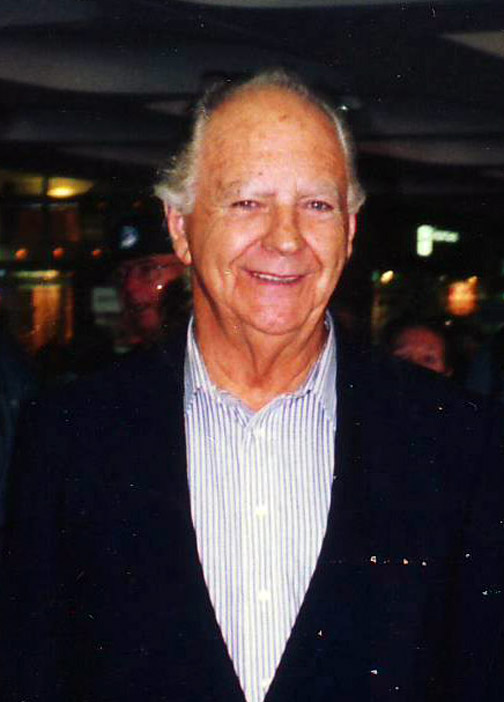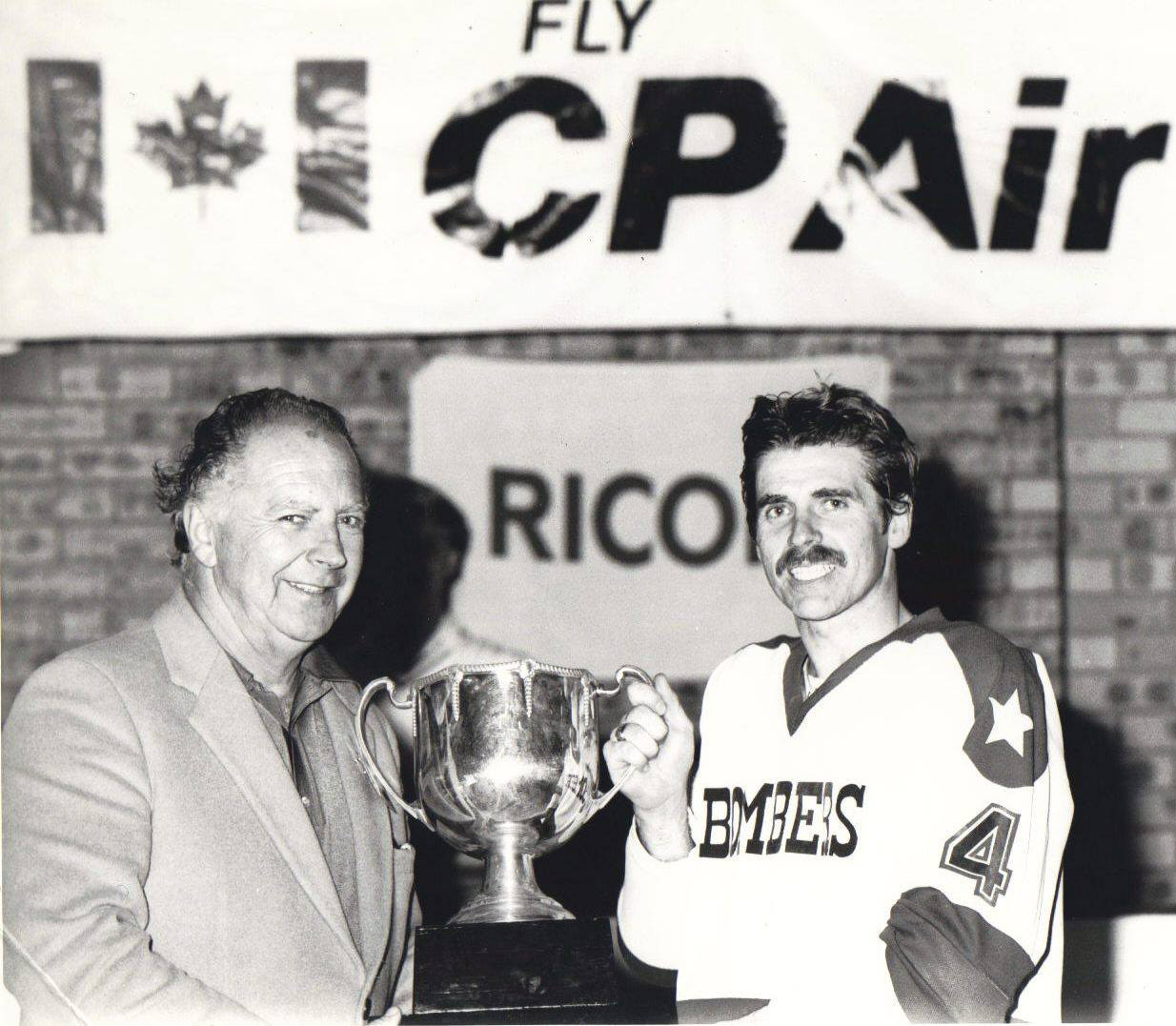


[Top] Sydney, 1994. Full image: Phil Ginsberg, with grandson Matt Clark third from left. On the left is Jamie Jory and right is Paul Hardwick.
[Middle] On left with Allan Harvey, Bombers, National Ice Hockey League Champions, 1981. Courtesy Allan Harvey. The photo was once on display in the Australian section of the International Ice Hockey Hall of Fame, Toronto.
[Bottom] Letter, AIHF to Victorian ice hockey player, Darren Burgess, on the occasion of the inaugural National Junior Team, 10 January 1983. Courtesy Darren Burgess.
CAREER SUMMARY
Birth
October 2nd 1923
Wellington New Zealand
Death
September 1st 1998
Balmoral Beach NSW Australia
Clubs
NSWIHA Homebush Juniors
Goodall Cups
Nil
Life Memberships
State and national associations
Sport administrator/IIHF delegate
President, state/national associations
"Sportsman of the Year" 1981 (Hudson Trophy)
Order of Australia (Ice Hockey)
Father of Phillip Ginsberg Jr
Grandfather of Matt and Corey Clark
Namesake, Ginsberg Memorial Trophy (U13)
BORN OCTOBER 2ND 1923 at Wellington, New Zealand, the son of Raleigh Isadore Ginsberg and his wife Clarice, the family lived in Adelaide during his early years, before finally settling in Sydney. Ginsberg's introduction to ice hockey came in 1938 when he joined a coaching clinic organised at the Ice Palais by Jimmy Bendrodt's imported Canadian Bears team. At 14, with the World War looming, he decided on goal keeping.
Enlisting in the Army late in 1942, he served at the NSW District Accounts Office until war's end. In 1947, he married Sheila Ivy O'Brien in North Sydney, and moved to LA for business reasons. He rekindled an interest in amateur ice hockey there, and on his return to Australia, became involved with the Homebush Juniors in the early 1960s. After their demise, he continued his interest in senior hockey.
Appointed state delegate to the national association in 1978, Ginsberg became state president in 1979, and national president in December 1980. Ginsberg's new administration included Sandi Logan (secretary), Charlie Grandy (vice president), Elgin Luke (coaching director), Terry Mouland (treasurer) and Paul Chartrand (referee-in-chief). Sid Neate handled the sports medicine and former Brandon University Bobcat, Mike Johnston, assisted Luke.
Ginsberg took office after the first season of the National Ice Hockey League which, according to Syd Tange, had been a dream unopposed by six presidents, despite concerns over how to fund it. "His knowledge gained partly in Los Angeles proved invaluable to Australian hockey," wrote Tange in 1999.
The rink operator's association led by Pat Burley who initiated the League, sought greater involvement of the sport's controlling authorities for the second season in 1981, and it floundered when refereeing problems emerged, sponsorship and promotion proved insufficient to cover expenses, and the spectator capacities of some rinks were inadequate to generate enough revenue.
That year, the national association awarded Ginsberg the SM and HC Hudson "Sportsman of the Year" for unbroken continuous service to Australian ice hockey for 10 years. Pressured to act on the displacement of many local players by overseas players in some NIHL teams, Ginsberg withdrew support for the League, announcing the national association would focus on juniors in 1982, but would not stand in the way of those who wanted to pursue it commercially. "As an amateur organisation, and as a member of the Australian Olympic Council," he said, "it is our mandate to develop the up-and-coming Australian boys". It was a decision that disappointed many.
In the aftermath of the NIHL, Ginsberg shut down a commercial ice hockey league in Victoria built around imported players, on the grounds that it was too violent. In later years, his support for Australian-born players in national tournaments was sometimes at the expense of more skilled or experienced New Australians. His administration was also pressured to remove barriers to women in the sport, which it gradually did, although progress was painfully slow.
In 1983, his national board introduced a classification called the President's Cup for players 13-years and under. Ginsberg presented the original trophy for the inaugural series hosted in Adelaide. After his death on September 1st 1998 [1] at Balmoral Beach NSW, the national association renamed the Under-13 national ice hockey trophy in his memory. A life member of state and national associations, the words "Mr Ice Hockey" are inscribed on his gravestone at North Ryde. Survived by his wife, Sheila, he is interred with his son, Phillip, who died young on October 3rd 1988. [1]
His daughter Shayne's sons, Matt and Corey Clarke, were introduced to the game by Phillip Jnr, who was born in 1952 and played for the Newcastle Bombers in 1979. Matt represented Australia in the Under-18 IIHF Asia-Oceania Junior Ice Hockey Championships in Seoul in 1993, and in Beijing in 1994, but died of leukaemia in 1995 at the age of 18. The Matt Clark Memorial Shield is named in his memory. "Phillip Ginsberg did so much for the sport of ice hockey in Australia and New Zealand," recalls Stephen Gibson, "and his fantastic family should be very proud".
During Ginsberg's 18-year tenure as national president, he was a delegate to the IIHF and among his administration's achievements are the first sponsorship with Air Canada that produced the all-time high in visits from touring overseas teams; productive links with the Australian Institute of Sport; increased funding from government and the IIHF; decreased reliance on cigarette and alcohol sponsorship; the first accredited national coaching scheme; the first Under-13 national competition; the first National Youth Team (U18), and the first National Junior Team (U21).
Under Ginsberg's administration, the number of imports permitted in NSW Superleague teams had dropped from 8 to 4 by 1984, and the national association spoke seriously, although unsuccessfully, of returning ice hockey to the Olympics in Calgary in 1988. But these and other progressive initiatives were marred by several bitter controversies arising from regressive policies or practices that discriminated against young female ice hockey players. Or discriminated against male players who were born overseas, but who were natural immigrants with legitimate entitlement to the same opportunities as locals.
The latter can be viewed as affirmative action promoting the group of home grown players who are known to have previously suffered from discrimination. "Phil Snr was certainly a man who saw a future for Australians playing hockey," notes former vice-captain of Australia, Allan Harvey, "not just imports playing hockey in Australia". Locally developed players were often excluded from their National League or National Teams, often by overseas-born coaches, in favour of players with skills and experience gained in overseas development leagues that were not open to most Australians. [3]
"Mr Ginsberg had faith in me when others didn't," recalls a grateful Michael King. "If not for him, I would not have been associated with the 1998 Australian Women's team and the NSW Women's Joan McKowen champions. Also going to Assebet Valley in Concord MA, USA. I was an assistant coach and ended up coaching for Carl Gray for Assebet Valley and winning the silver medal at the 2007 USA national for Under-16 Women". [3]
Ginsberg's term is also notable for the new breed of coaches who were better educated for the task, and more interested in developing local hockey than importing ready-made players from hockey nations overseas. These included the spate of graduates from the Brandon University Bobcats; Jim Fuyarchuk who formulated the Under-18 National Youth Team program with John Botterill, and Ryan Switzer, whose Australian National Senior Team squads of the early 1990s produced Australia's best international results.
Ross Carpenter, 'Ginsberg, Phillip OAM (1923-1998)', Legends of Australian Ice, Melbourne, Australia, http://icelegendsaustralia.com/legends-2/bio-ginsberg.html, accessed online .
[2] Legends of Australian Ice Facebook, October 2018. Comments by Sheila Ginsberg and Stephen Gibson.
[3] Legends of Australian Ice Facebook, February 2018. Comments by Michael King and Allan Harvey. For example, the vast majority of players on the 1987 National Senior Team for the inaural IIHF D-Pool Worlds hosted at home in Perth, were neither born nor developed in Australia. Similarly, the vast majority of overseas players on many of the Australian NIHL teams of the early 1980s were developed overseas and/or imported.
Citations | 1 - 280 | 281-on |
